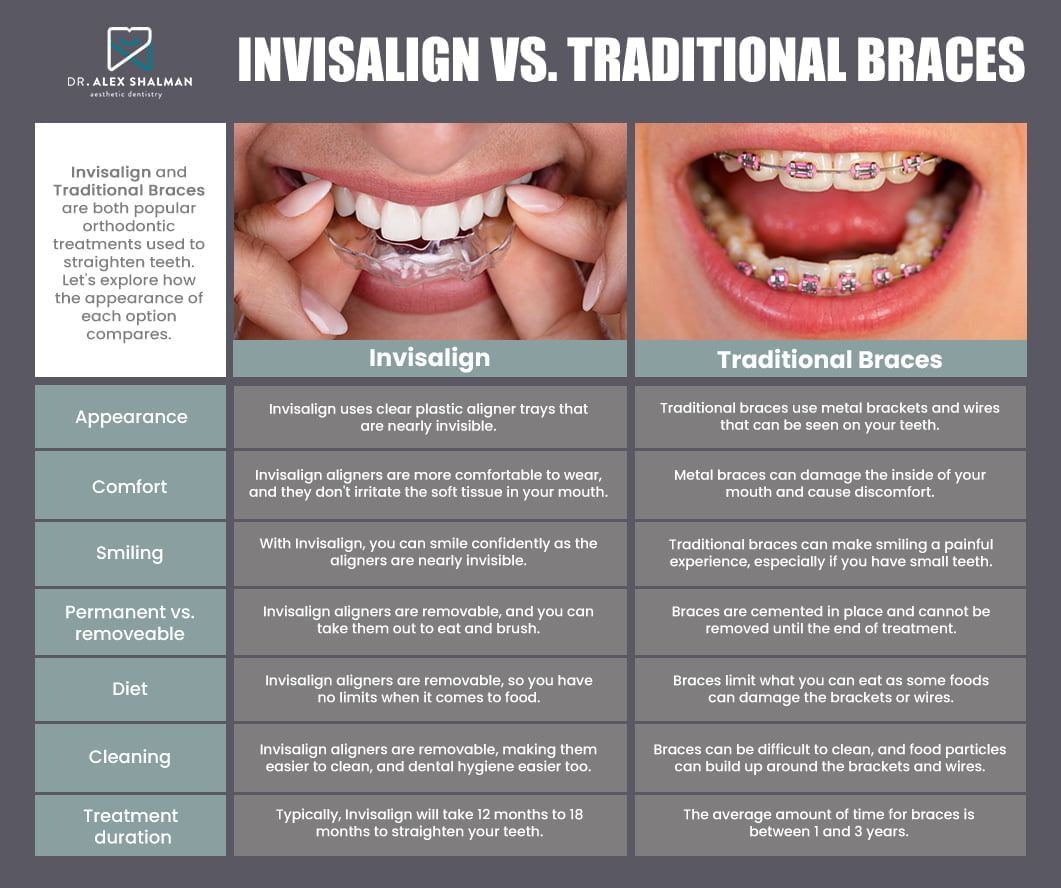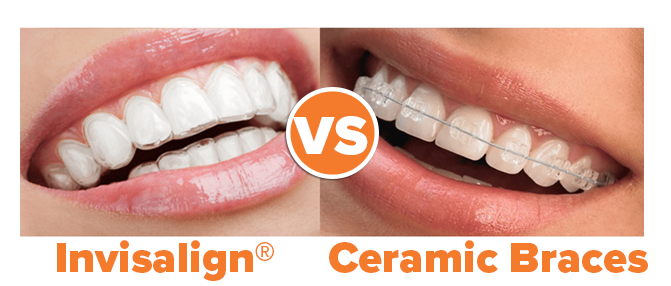Invisalign vs. Standard Dental braces: Which Choice Is Right for You?
When considering orthodontic treatment, the choice between Invisalign and typical braces offers numerous essential variables that warrant cautious evaluation. Invisalign provides a discreet choice with removable aligners, while standard dental braces supply a much more visible yet efficient option for serious imbalance. Each alternative includes distinct advantages and disadvantages connected to looks, convenience, treatment period, and price. Comprehending these nuances is crucial for making an informed choice that aligns with your personal choices and lifestyle. The inquiry continues to be: which option will best fulfill your orthodontic needs and assumptions?
Summary of Therapy Alternatives

On the other hand, standard dental braces contain steel brackets and wires that are bound to the teeth. This technique uses continuous pressure gradually to accomplish positioning. While effective for complicated orthodontic problems, conventional dental braces need routine brows through for modifications and can posture difficulties in preserving oral hygiene due to the difficulty of cleansing about brackets and wires.
Both choices have their values, and the selection usually depends upon particular dental problems, lifestyle preferences, and person conformity. Inevitably, seeking advice from an orthodontic expert is essential for identifying one of the most suitable therapy plan tailored to private needs. Understanding the nuances of each option can considerably affect the total success of orthodontic therapy.
Aesthetic Factors To Consider
A considerable element affecting the choice in between Invisalign and traditional dental braces is the aesthetic appeal each therapy provides. Invisalign aligners are crafted from clear plastic, making them practically unseen when used. This discreet appearance is especially attracting adults and teens who might feel uneasy regarding their orthodontic treatment. The ability to preserve a natural smile throughout the positioning process can considerably enhance the individual's confidence in specialist and social setups.
On the other hand, conventional dental braces contain steel braces and wires, which can be more visible. While innovations in orthodontic modern technology have actually caused the development of smaller sized brackets and tinted elastics, traditional dental braces still keep a more conspicuous account. For some individuals, the presence of braces may hinder them from looking for necessary therapy.
Inevitably, the option in between Invisalign and conventional dental braces may pivot on individual preferences regarding aesthetic appeals. People that prioritize discernment usually lean toward Invisalign, while those that are less concerned concerning visibility may choose typical braces. Comprehending the visual effects of each option is important for making an educated choice that aligns with one's way of life and choices.
Convenience and Convenience

In terms of convenience, Invisalign aligners are detachable, making it possible for individuals to enjoy their favorite foods without constraint and preserve optimal dental health. Brushing and flossing are streamlined, as the aligners can be secured during these routines, whereas typical braces require mindful steering around brackets and cords.
In addition, Invisalign's dynamic system permits for fewer orthodontic gos to. People generally receive multiple collections of aligners at the same time, which can streamline the therapy procedure and reduce time invested in the orthodontist's chair. In contrast, conventional dental braces require regular modifications, making them less practical for those with busy routines. Invisalign. Overall, the convenience and comfort of Invisalign make it an appealing selection for numerous people looking for orthodontic treatment.
Therapy Duration and Efficiency
While both Invisalign and typical braces are efficient in remedying oral misalignments, the duration of treatment can differ considerably in between the find out this here 2 options. Usually, Invisalign therapy can take anywhere from 12 to 18 months, relying on the complexity of the case. The clear aligners work by progressively changing teeth right into their desired positions, and routine follow-ups with an orthodontist assistance make sure progression continues to be on track.
In contrast, conventional braces typically need a longer dedication, generally varying from 18 months to important link 3 years. This results from their set nature and making use of cords and braces, which can be extra reliable for intricate situations and serious misalignments (Invisalign). The treatment effectiveness of conventional braces is well-documented, as they enable accurate adjustments and greater control over tooth movement
Inevitably, the selection in between Invisalign and traditional dental braces might pivot on both the expected treatment period and the details oral problems available. Consulting with an orthodontist is essential, as they can provide tailored referrals based upon individual needs, making certain the picked technique aligns with wanted end results and durations.
Expense Comparison and Insurance Policy Alternatives
Cost plays a considerable role in the decision-making procedure for individuals considering orthodontic therapy, whether choosing for Invisalign or page conventional dental braces. Generally, the cost of Invisalign arrays from $3,000 to $8,000, while conventional dental braces normally cost in between $2,000 and $6,000. Elements affecting these expenses consist of the complexity of the case, the duration of therapy, and geographical place.
Insurance protection can significantly influence out-of-pocket expenses. Lots of dental insurance policy plans supply partial coverage for orthodontic therapies, but the specifics can vary extensively. It is important for patients to evaluate their insurance plan to establish the extent of protection for either alternative. Typically, typical braces might be extra often covered by insurance policy plans compared to Invisalign, which some insurers categorize as an aesthetic treatment.
Furthermore, several orthodontic practices supply versatile layaway plan, making both therapy options more accessible. Patients must ask about possible funding alternatives and discounts for ahead of time payments. Reviewing the total expense, including insurance policy benefits and layaway plan, is vital for making an educated choice that aligns with both aesthetic choices and budget factors to consider.

Conclusion
In recap, the option between Invisalign and standard braces depends upon several aspects, including aesthetic choices, convenience, therapy period, and price. Invisalign offers a discreet, removable option that promotes dental hygiene and dietary adaptability, while traditional dental braces might be extra appropriate for complex dental problems and typically come with a lower price point. Ultimately, consultation with an orthodontist is vital to evaluate individual situations and establish one of the most proper treatment alternative for accomplishing ideal oral placement.
When thinking about orthodontic therapy, the selection in between Invisalign and conventional dental braces provides numerous essential variables that merit mindful analysis.Comparing Invisalign and standard braces reveals distinctive therapy choices for orthodontic correction.While both Invisalign and standard dental braces are reliable in fixing oral imbalances, the duration of therapy can differ dramatically in between the 2 options.Expense plays a significant role in the decision-making procedure for individuals taking into consideration orthodontic therapy, whether opting for Invisalign or traditional dental braces.In recap, the selection in between Invisalign and typical braces hinges on several variables, including aesthetic preferences, convenience, treatment period, and expense.
Comments on “How Invisalign Works: Your Overview to Clear Aligners and Their Effectiveness”